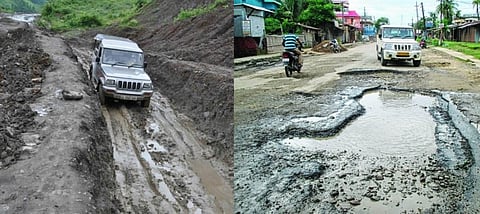
- Home
- Live Blog
- Breaking News
- Top Headlines
- Cities
- NE News
- Sentinel Media
- Sports
- Education
- Jobs

The state of the roads of Assam has become a cause of major concern for everyone who has to use them during the monsoon months. One gets the unmistakeable impression that the PWD and the other authorities of the Assam government responsible for the maintenance of our roads and highways are concerned only with the highways and are totally negligent of the smaller roads linking our villages. Even so, their ability to maintain even the highways are now open to question considering that during the days of very heavy rainfall even NH37 remained closed for a day or two in some parts of upper Assam. This is something that should never happen in any State. True, this year the rains have been very heavy, but this is nothing really new for Assam. Unfortunately, what should happen every year but does not is purposeful planning for the floods and the proper protection of our roads and highways. This year, the State highways are beginning to look like ordinary roads and the roads linking the villages have the distinct appearance of mud fields with huge potholes on which no vehicle can move with even a vestige of safety.
There are two facets to this total disruption of road traffic on village roads that deserve serious concern. The first is the quality of road repair and road maintenance that our contractors can get away with year after year. Even the layman can judge the quality of road repair and maintenance work for which contractors are getting paid. There is no sign of the use of stone chips, gravel and sand. It is as though the contractors engaged used only earth as building material for all village roads. Not to speak of trucks and other larger vehicles, even motor cycle riders have to get off their bikes and push them along the very muddy stretches of the village roads. The other facet of the problem is that with a great deal of unwarranted resistance to any kind of hydro-electric project for Assam, during the monsoon months the excess of water is allowed to flow freely without any hindrance all over the State. The requisite number of hydro-electric projects that would have required the excess water to flow in a controlled way is missing. Even a fair number of irrigation projects would have ensured greater control of the water that now flows unrestrained and with such abundance during the monsoon months. And such projects cannot be commissioned without years of careful planning to bring in the required Central grants for their implementation. None of the attributes of planned administration are in evidence. What is much in evidence is the large-scale spending of Central funds on unplanned or incompletely planned activities with very little thought for what would be of the greatest good for the greatest number.
There is little room for dispute about the need for greater control over the water that now flows freely across the State during the monsoon, causing extensive damage to property and loss of lives. It is depressing to see so many rural families having to abandon their hearths and homes and live on our highways during the monsoon months year after year. This is the kind of situation that any administration worth its salt must be able to anticipate and prevent if all our talk about respect for human lives and human dignity are not to be cynically dismissed as mere politically correct verbiage adding up to nothing at all.